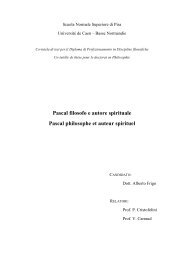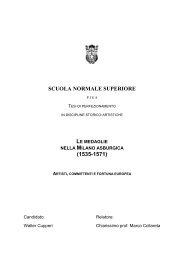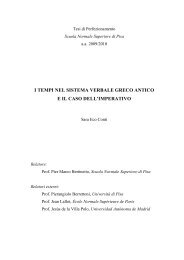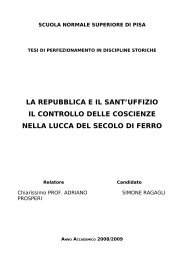CATULLUS 68 - Scuola Normale Superiore
CATULLUS 68 - Scuola Normale Superiore
CATULLUS 68 - Scuola Normale Superiore
Create successful ePaper yourself
Turn your PDF publications into a flip-book with our unique Google optimized e-Paper software.
At first sight, this debate could appear to be merely about whether or not to divide up a semi-continuous text<br />
along its internal joints, about editorial tastes and preferences rather than questions of interpretation. The<br />
following pages should make it clear that this is not the case. In fact, the proponents of unity and those of<br />
division have put forward entirely different interpretations of carmen <strong>68</strong>. This controversy is not about mere<br />
editorial choice, but about what is the substance of this poem or of these poems; and as such, it has to be<br />
considered carefully.<br />
Carmen <strong>68</strong> appears as one poem in Catullus’ manuscripts as well as in the great editions of the Renaissance.<br />
Lines 1-40 were first printed as a separate poem in 1785 in an anthology of Latin poetry translated into<br />
German by the man of letters, diplomat and statesman August Rode (1751-1837, after attaining nobility in<br />
1803 von Rode). 10 He explains why he has done so in his introductory note:<br />
“In Brindley’s edition, which I have before me, [this poem] is about 120 verses longer; but it appears<br />
from their contents that they do not belong to this letter. They constitute a separate poem in praise of<br />
Manlius, which is not of the best sort, and in which the apostrophe to Catull’s dead brother is repeated<br />
almost literally. I have felt it justified to leave out this pitiful appendage.” 11<br />
Rode’s anthology was not a critical edition and it did not even contain a Latin text of the poems that he had<br />
translated; however, his separation of lines 1-40 from the rest of the poem was soon taken up in a slightly<br />
more scholarly work, the bilingual 1793 pocket edition published by his acquaintance the poet, translator and<br />
literary critic Karl Wilhelm Ramler (1725-1798). 12 As an editor of contemporary German poetry, Ramler<br />
was notorious for re-writing passages that he found deficient, for which Goethe duly lampooned him as “the<br />
crab in B***” (Berlin), whose pincers clip off many a burgeoning poetic flower, and as a barber who shaves<br />
his customers free but against their will and cuts into their skin and nose. 13 He dealt with Catullus along<br />
similar lines: he bowdlerized the text thoroughly, removing all obscenity and turning homosexual love affairs<br />
into heterosexual ones. As for poem <strong>68</strong>, he treated its first forty lines as a separate poem, giving in a footnote<br />
the same reasons for this that had already been given by Rode; and in an egregious case of the pot<br />
10<br />
Rode 1785: 81-85. On Rode see Hofäus 1889 and Arndt 1936.<br />
11<br />
Rode 1785: 81f. “In der Brindleyschen Ausgabe, die ich vor mir habe, ist er [sc. der Brief] noch um 120 Verse<br />
länger; allein der Inhalt derselben zeigt, dass sie nicht zu dieser Epistel gehören. Sie machen ein eignes Lobgedicht auf<br />
den Manlius aus, welches eben nicht von der besten Art ist, und worin die Apostrophe an den verstorbenen Bruder<br />
Katulls fast wörtlich wiederholt wird. Ich habe mich berechtiget geglaubt, diesen elenden Anhang weg zu lassen.”<br />
12<br />
On Rode’s acquaintance with Ramler see Arndt 1936: 194; on Ramler see Petrisch 1888 and Fromm 1998. His<br />
pocket-sized Catullus of 1793 has become very rare, its 1803 reprint (with a different layout and less footnotes)<br />
somewhat less so.<br />
13<br />
J.W. von Goethe, Xenien 74 and Das Neuste von Plundersweilern 59-70; see also Xenien 106 and 358f.<br />
11






